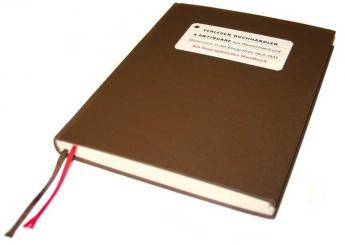Heinrich Eisemann

He was one of the great antiquarian booksellers and widely known as “Mister Ten Per Cent”.
Heinrich Eisemann, born in 1890 in Frankfurt / Main. After an apprenticeship at a publishing house he moved to rome in 1907. As a partner of LIBRERIA LANG he spent the years of World War I in Switzerland. Then, in 1921, he founded a prestigious rare book company specializing in medieval manuscripts in Frankfurt / Main.
Eisemann, who was married to the daughter of the art dealer M. S. Goldschmidt, was known only to connoisseurs of the rare book trade, because he did not publish any catalogues. From 1923 to 1927
worked together with Isidor Mendel as directors of the Hermon Verlags AG, later the Israelit and Hermon GmbH until 1935. In this position Eisemann was editor of the Frankfurter Wochenblatt.
He was forced by the Nazis to close his shop, to abandon his antiquarian bookshop and to leave the country. On 31 March 1937 Eisemann’s company officially expired, and on 12 March 1941 his family was officially expatriated, all money was confiscated by the Gestapo.
With the help of English art dealers Heinrich Eisemann reestablished his antiquarian book business in London. He was one of the rare book dealers to build up the Schocken Library in Berlin, Jerusalem and New York. Eisemann, a cosmopolitan, had excellent contacts to collectors. Most of the time he bought and sold on behalf of important collectors and acted as their representative during the auctions at Christie’s, Sotheby’s and other auction houses. Eisemann’s colleague Bernd H. Breslauer wrote about him:
“He acted almost exclusively as a middleman, buying and selling on commission which earned him another sobriquet, that of "Mr. Ten Per Cent".”
Perhaps his most famous client was the Swiss collector Martin Bodmer. Heinrich Eisemann worked as antiquarian bookseller in London until 1965. The Times wrote about him:
“His unrivalled knowledge of medieval illuminated manuscripts and early printed books placed him in the first rank of world booksellers. In addition to this, he had a unique knowledge of the drawings of Duerer, Cranach, Rubens and Rembrandt and almost unrivalled knowledge of the autographs of Luther, Goethe and Heine' ( The Times).“
His library was auctioned at Sotheby’s from 18 to 20 April 1966. Heinrich Eisemann died in 1972.
A more detailed account of „Mister Ten Per Cent“ Heinrich Eisemann’s life and career is given in Ernst Fischer’s biographical handbook "Verleger, Buchhändler & Antiquare aus Deutschland und Österreich in der Emigration nach 1933":
Eisemann, Heinrich 5. 8. 1890 Frankfurt / Main - 4. 12.1972 London; Antiquar
Heinrich Eisemann übersiedelte nach seiner Ausbildung im Frankfurter Verlagsbuchhandel 1907 nach Rom. Als Teilhaber der LIBRERIA LANG verbrachte er die Jahre des Ersten Weltkrieges in der Schweiz. 1921 gründete er ein angesehenes Antiquariat für mittelalterliche Bilderhandschriften in Frankfurt I Main, er war verheiratet mit der Tochter von M. S. Goldschmidt, einem renommierten Kunsthändler.
Da er als Antiquar auf ein Ladengeschäft und die Herausgabe von Katalogen verzichtete, war Eisemann nur Kennern der Branche bekannt. Von 1923-27 fungierte er gemeinsam mit Isidor Mendel auch als Direktor der HERMON VERLAGS AG, die danach in den Verlag des Israelit und Hermon GmbH aufging, der offenbar bis 1935 bestanden hat. Eisemann hat sich also um die Herausgabe des Frankfurter Wochenblatts Der Israelit verdient gemacht; auch war er Mitglied der Kommission zur
Erforschung der Geschichte der Frankfurter Juden.
Mit 31. März 1937 musste er auf behördliche Anordnung seinen florierenden Antiquariatshandel beenden. In einem Aktenvermerk über die Firma HEINRICH EISEMANN, Devisenstelle Frankfurt vom I2. Mai I941, heißt es:
„Eisemann und seine Familie wurden ausgebürgert, seine Vermögenswerte sowie die seiner Frau und Kinder von der Geheimen Staatspolizei Frankfurt/M. beschlagnahmt.“
Mit Hilfe von englischen Kunsthändlern führte Heinrich Eisemann von 1937 an seinen Handel in London weiter. Er beteiligte sich am Aufbau der Schocken-Bibliotheken in Berlin, Jerusalem und New York. Der Kosmopolit Eisemann verfügte über gute Kontakte zu Sammlern und handelte hauptsächlich mit der Vermittlung von Autographen, Inkunabeln und Kleinoden der Malerei. Für einige bedeutende Sammler bot er bei den Versteigerungen von Sotheby's und Christie's auf die gewünschten Objekte. Sein Kollege Bernd H. Breslauer beschrieb seine Tätigkeit folgendermaßen:
“He acted almost exclusively as a middleman, buying and selling on commission which earned him another sobriquet, that of "Mr. Ten Per Cent".”
Sein bekanntester Auftraggeber war wohl der Schweizer Sammler Martin Bodmer. Bis 1965 betätigte sich Eisemann in London erfolgreich als Antiquar:
“His unrivalled knowledge of medieval illuminated manuscripts and early printed books placed him in the first rank of world booksellers. In addition to this, he had a unique knowledge of the drawings of Duerer, Cranach, Rubens and Rembrandt and almost unrivalled knowledge of the autographs of Luther, Goethe and Heine' ( The Times).“
Heinrich Eisemann’s Handbibliothek wurde vom 18. bis 2o.April 1966 in London bei Sotheby's versteigert.
Literature
BHE 1; Adressbuch 1928 (S.11), 1935; Verlagsveränderungen 1900-1932 S. 29; HOMEYER: Bibliophilen und Antiquare (1966) S.137; FRIED LÜBBECKE: Fünfhundert Jahre Buch und Druck in Frankfurt am Main. Frankfurt / Main: H. Cobet 1948 S. 202; EDUARD TRAUTSCHOLD: 50jähriges Berufsjubiläum von Heinrich Eisemann. In: Bbl. (FfM) Nr. 26 vom 29.3. 1957 S. 410; HEIDI DÜRR: Frankfurter Antiquare heute. In : Bbl. (FfM) Nr. 77 vom 28.7.1973 S. A 425 [Hinweis auf einen Nachruf in: The Times, 12 Dec. 1972]; BERND BRESLAUER: Martin Bodmer remembered. In: Book Collectorvol. 37 no. 1 (1988) pp. 43 f.; BACH, BIESTER: Exil in London (2002) S. A 255 f.
Ernst Fischer: Verleger, Buchhändler und Antiquare aus Deutschland und Österreich in der Emigration nach 1933. Ein biographisches Handbuch.
With an essay and 20 photographs. Book design: Ralf de Jong. Elbingen, Verband Deutscher Antiquare, 2011. 431 pp., Cloth.
The International League of Antiquarian Booksellers is proud to publish some of the most impressive stories told in Ernst Fischer’s biographical handbook. For more information please visit the website of the German Antiquarian Booksellers' Association (VDA)

